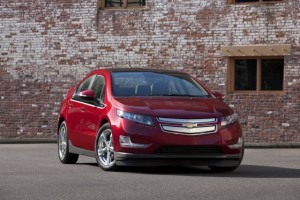 Any reasonable assessment of a hybrid or EV automobile with a premium price tag must consider the break-even point achieved through lower ownership costs, right? In this 2012 Chevrolet Volt review, surely I’ll explain how, over time, plugging in saves money compared with filling up, allowing a rational person to get over the Volt’s relatively high bottom line. Well, no.
Any reasonable assessment of a hybrid or EV automobile with a premium price tag must consider the break-even point achieved through lower ownership costs, right? In this 2012 Chevrolet Volt review, surely I’ll explain how, over time, plugging in saves money compared with filling up, allowing a rational person to get over the Volt’s relatively high bottom line. Well, no.
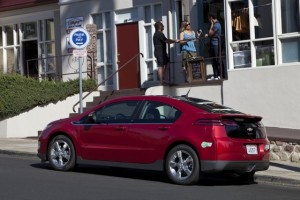 In a real-world test of AutoTrader.com’s long-term 2011 Volkswagen Jetta TDI, I considered that vehicle’s excellent fuel economy versus its $2,500 price premium and the high cost of diesel fuel. I did the same with the Nissan Leaf, attempting to figure out just how inexpensive electric power offsets its high MSRP. But honestly, I really enjoyed driving both of those cars, and after spending some time with them, I started to feel like their pricier powertrains were luxuries that didn’t require a rational, spreadsheet-driven decision-making process. I like the TDI. Can I just buy it or the Leaf because I like the torque, because I find it to be a satisfying vehicle to drive?
In a real-world test of AutoTrader.com’s long-term 2011 Volkswagen Jetta TDI, I considered that vehicle’s excellent fuel economy versus its $2,500 price premium and the high cost of diesel fuel. I did the same with the Nissan Leaf, attempting to figure out just how inexpensive electric power offsets its high MSRP. But honestly, I really enjoyed driving both of those cars, and after spending some time with them, I started to feel like their pricier powertrains were luxuries that didn’t require a rational, spreadsheet-driven decision-making process. I like the TDI. Can I just buy it or the Leaf because I like the torque, because I find it to be a satisfying vehicle to drive?
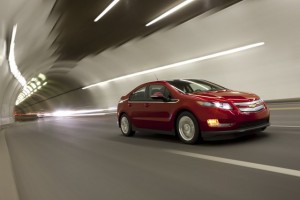 Earlier this summer, I drove a decked out, gas-guzzling luxury SUV that changed my mind about rationalizing economy. I realized that no one ever questions why car shoppers spend extra money on panoramic sunroofs, adaptive cruise control or seats that blow cool air on your backside. No discussion takes place about how often those functions are used versus the price of the optional equipment, or what fraction of their costs can be recouped upon resale. So I’m throwing out the spreadsheet, because I really enjoy driving the Chevy Volt.
Earlier this summer, I drove a decked out, gas-guzzling luxury SUV that changed my mind about rationalizing economy. I realized that no one ever questions why car shoppers spend extra money on panoramic sunroofs, adaptive cruise control or seats that blow cool air on your backside. No discussion takes place about how often those functions are used versus the price of the optional equipment, or what fraction of their costs can be recouped upon resale. So I’m throwing out the spreadsheet, because I really enjoy driving the Chevy Volt.
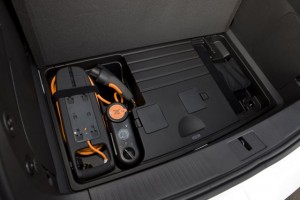 Because most of my driving is done close to home on city streets, I used only a tiny bit of gasoline in the Volt. In fact, I probably would have used none if I’d not been interested in testing how the gasoline engine-generator performed. I simply plugged the Volt in at night and had no issues maintaining sufficient range. Compared with the Leaf – which I drove to the suburbs and back with just a bit of energy to spare – the Volt resulted in no range anxiety, thanks to the peace of mind provided by the gasoline-powered engine.
Because most of my driving is done close to home on city streets, I used only a tiny bit of gasoline in the Volt. In fact, I probably would have used none if I’d not been interested in testing how the gasoline engine-generator performed. I simply plugged the Volt in at night and had no issues maintaining sufficient range. Compared with the Leaf – which I drove to the suburbs and back with just a bit of energy to spare – the Volt resulted in no range anxiety, thanks to the peace of mind provided by the gasoline-powered engine.
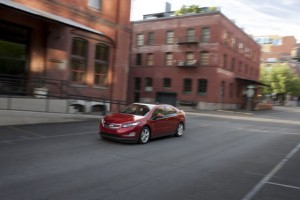 Still, I enjoy the EV driving experience in all its smooth and calming near-silence. The lack of vibration at idle is part of the chilled-out equation, too. Something about an internal combustion engine at idle – even in a well-insulated luxury car – makes a driver anxious at red lights or in heavy traffic. In the Volt, no motor is raring to go. No energy that could be used to move the vehicle is being wasted.
Still, I enjoy the EV driving experience in all its smooth and calming near-silence. The lack of vibration at idle is part of the chilled-out equation, too. Something about an internal combustion engine at idle – even in a well-insulated luxury car – makes a driver anxious at red lights or in heavy traffic. In the Volt, no motor is raring to go. No energy that could be used to move the vehicle is being wasted.
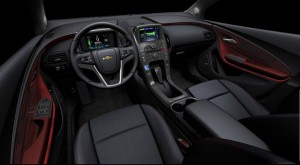 Whether stuck in traffic or traveling at speed, the Volt’s cabin is a pleasant place to be. The design is quite different from the Leaf, which has a softer feel and evokes that EV’s green side. Instead, the Volt feels technologically advanced and sporty, with capacitive touch controls in the center stack and a slick, split rear seat, bisected by a central tunnel that provides space for the batteries. Although the Volt is not a large vehicle, space proved sufficient for my family of four, and the hatchback design provides decent cargo volume.
Whether stuck in traffic or traveling at speed, the Volt’s cabin is a pleasant place to be. The design is quite different from the Leaf, which has a softer feel and evokes that EV’s green side. Instead, the Volt feels technologically advanced and sporty, with capacitive touch controls in the center stack and a slick, split rear seat, bisected by a central tunnel that provides space for the batteries. Although the Volt is not a large vehicle, space proved sufficient for my family of four, and the hatchback design provides decent cargo volume.
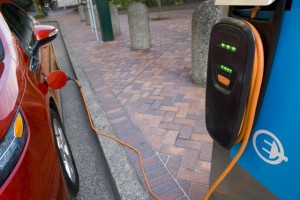 My First Look at the 2012 Chevrolet Volt outlines some of the specifications and equipment on the test car and includes some details on pricing. At around $40,000, the Volt is not cheap. But it actually stands a chance of making up for its price premium over a similar conventionally powered car in the long run. That’s an advantage that a loaded luxury model does not typically offer. In the meantime, the Volt is also a joy to drive. Plus, I got free juice from a local EV charging station while I was shopping. I’ve yet to find a free gas pump anywhere.
My First Look at the 2012 Chevrolet Volt outlines some of the specifications and equipment on the test car and includes some details on pricing. At around $40,000, the Volt is not cheap. But it actually stands a chance of making up for its price premium over a similar conventionally powered car in the long run. That’s an advantage that a loaded luxury model does not typically offer. In the meantime, the Volt is also a joy to drive. Plus, I got free juice from a local EV charging station while I was shopping. I’ve yet to find a free gas pump anywhere.
If you think you might enjoy the EV experience but haven’t yet had a chance to find out, test drive a Volt. If you like it and it meets your budget constraints, forget the spreadsheet and enjoy the ride.

